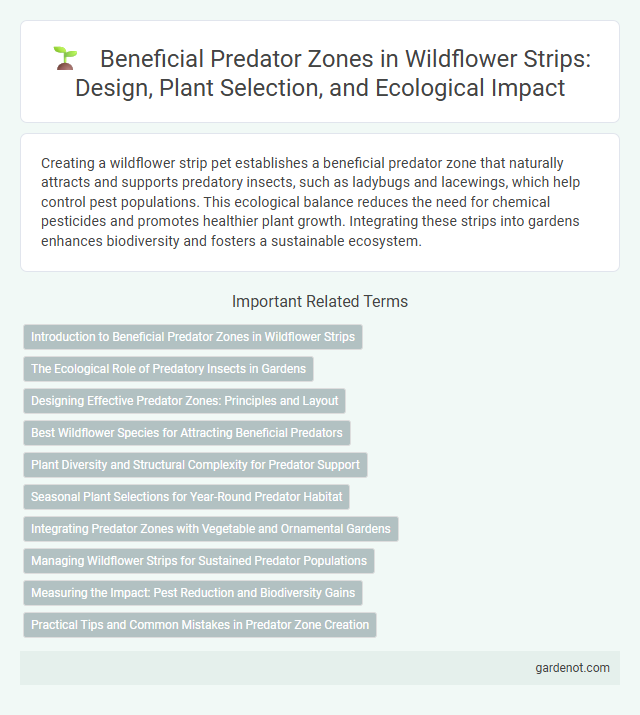Creating a wildflower strip pet establishes a beneficial predator zone that naturally attracts and supports predatory insects, such as ladybugs and lacewings, which help control pest populations. This ecological balance reduces the need for chemical pesticides and promotes healthier plant growth. Integrating these strips into gardens enhances biodiversity and fosters a sustainable ecosystem.
Introduction to Beneficial Predator Zones in Wildflower Strips
Beneficial predator zones within wildflower strips create essential habitats that attract natural enemies of crop pests, enhancing biological control and reducing pesticide reliance. These zones foster diverse populations of predatory insects such as lady beetles, lacewings, and parasitic wasps, which contribute to pest suppression in adjacent agricultural fields. Establishing wildflower strips with carefully selected plant species optimizes the environment for beneficial predators, promoting ecosystem balance and sustainable crop production.
The Ecological Role of Predatory Insects in Gardens
Predatory insects in a wildflower strip serve as a natural pest control, reducing populations of harmful garden pests such as aphids and caterpillars. These beneficial predators, including ladybugs, lacewings, and predatory beetles, enhance biodiversity and promote a balanced ecosystem within the garden. By supporting these insect populations, gardeners can decrease reliance on chemical pesticides and foster healthier plant growth.
Designing Effective Predator Zones: Principles and Layout
Designing effective beneficial predator zones within wildflower strips involves incorporating diverse native plant species that attract and sustain populations of key natural enemies such as lady beetles, lacewings, and parasitic wasps. Strategic layout principles emphasize creating continuous habitat corridors adjacent to crop fields to facilitate predator movement and maximize pest suppression. Optimal predator zones balance plant bloom periods and structural complexity to provide shelter, nectar, and pollen resources essential for predator survival and reproduction.
Best Wildflower Species for Attracting Beneficial Predators
Yarrow (Achillea millefolium) and Dill (Anethum graveolens) serve as top wildflower species in creating a beneficial predator zone due to their ability to attract lady beetles, lacewings, and parasitic wasps. These predators play a crucial role in controlling aphids, mites, and other crop-damaging pests, promoting natural pest management. Incorporating these wildflowers into agricultural landscapes enhances biodiversity while reducing dependence on chemical pesticides.
Plant Diversity and Structural Complexity for Predator Support
A wildflower strip with high plant diversity and structural complexity creates an optimal beneficial predator zone by providing varied habitats and abundant food resources. Diverse flowering plants attract a wide range of predatory insects like lady beetles and lacewings, enhancing natural pest control. Structural complexity offers shelter and breeding sites, supporting sustained predator populations critical for integrated pest management.
Seasonal Plant Selections for Year-Round Predator Habitat
Seasonal plant selections in wildflower strips create a year-round predator habitat by supporting beneficial insects like ladybugs, lacewings, and predatory beetles. Early spring blooms such as native violets and wild mustard provide shelter and nectar during predator emergence, while summer flowering plants like goldenrod and coneflowers sustain populations through peak insect activity. Fall and winter species, including asters and sedges, offer critical overwintering sites, ensuring continuous pest control throughout the growing season.
Integrating Predator Zones with Vegetable and Ornamental Gardens
Integrating beneficial predator zones within vegetable and ornamental gardens enhances natural pest control by attracting predatory insects such as ladybugs, lacewings, and parasitic wasps that suppress harmful pests. Strategic planting of wildflower strips adjacent to crops creates habitats rich in nectar and pollen, supporting predator populations year-round. This ecological approach reduces reliance on chemical pesticides, promoting healthier plants and sustainable garden ecosystems.
Managing Wildflower Strips for Sustained Predator Populations
Managing wildflower strips to sustain beneficial predator populations requires planting diverse native species that provide continuous bloom periods throughout the growing season. Incorporating structural complexity in the strips supports habitat for predators such as lady beetles, lacewings, and parasitic wasps, enhancing pest control services. Regular monitoring and adaptive management ensure that predator populations remain balanced and effective in reducing agricultural pests.
Measuring the Impact: Pest Reduction and Biodiversity Gains
Measuring the impact of a wildflower strip as a beneficial predator zone involves assessing reductions in pest populations such as aphids and caterpillars. Biodiversity gains are quantified by tracking increases in natural predator species like lady beetles, lacewings, and parasitic wasps. Data shows these zones result in up to 40% fewer crop pests and a 30% rise in beneficial insect diversity, enhancing overall ecosystem health and sustainable pest management.
Practical Tips and Common Mistakes in Predator Zone Creation
Creating a beneficial predator zone requires selecting native wildflower species that bloom sequentially to provide continuous nectar and habitat, supporting predatory insects like ladybugs and lacewings. Practical tips include avoiding pesticides, ensuring diverse plant height for varied shelter, and placing the strip near crops vulnerable to pests to maximize natural pest control. Common mistakes involve planting non-native species that fail to attract local predators, overcorrecting with monocultures, and situating strips too far from target areas, reducing their effectiveness.
Beneficial predator zone Infographic

 gardenot.com
gardenot.com